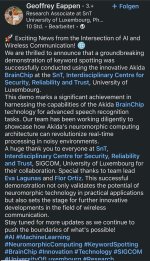New on the website
View attachment 61146
This new website reveal is interesting from a few perspectives, one notably is that this is dated 25 April !!!
So, perhaps we are 3 - 4 years and 5 days ahead of the pack with our tech. I can live with this I reckon.
SoCs featuring TENNs will be the way forward I hope, and introducing of course BRAINCHIP ( the latest offering ) with all it's MAGNIFICENCE included. Oh, How sweet it is, how sweet it is.
Let's hope it's a hit within the IoT world as we know it, I'm sure it will be, It's just a beautiful thing/picture IMO.
Akida Ballista >>>>> Lets' hope it appeals to the masses before tooo long ---- please ---- let it be so <<<<<
hotty...





